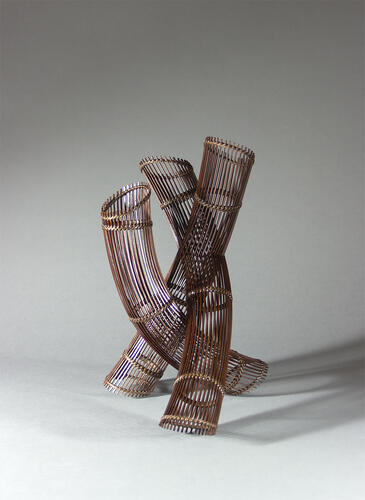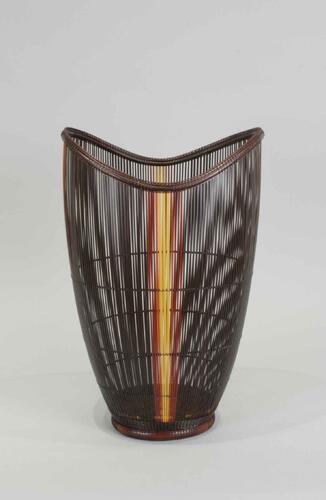Hasegawa Kei
In my work, the act of thinking acquires form; in particular when it comes to feelings between ourselves and others that are unable to be explained using conventional language.
Since about 2017, most of my work has revolved around looking at people close to me. The sensation is one of dismantling the subtle shifts in feeling sensed when around that person, and what might be causing those shifts, until the constituents of those feelings become apparent, then examining them from various angles, and reassembling them.
This sensation, and that of weaving strips of bamboo, are by nature very similar. Having dispersed the natural form of the bamboo by splitting it, I gather together strips with suitable properties and use them to compose a work. In the month or two it takes to complete the work, both bamboo and thoughts take on new forms, and the responses thus generated, mine alone, accumulate inside me.
Social currents move faster every year, and a huge sharing of culture is underway that transcends geography and race. So as not to lose sight of myself within that, I am continually engaging in thought to confirm my own existence. Hopefully at some point my practice will go beyond the self to prompt or inspire thoughts in others.
P r o c e s s
The work is created using traditional Japanese bamboo craft techniques. I split a whole culm of bamboo by myself into thousands of strips with a thickness of 0.3mm. After that, I gathered the strips together in groups of ten and wove them together using bundled plaiting. The bundled plaiting that I used in this work is a weaving method I devised myself based of the traditional technique of tabane ami. While this new weaving method incorporates the characteristics of the traditional technique, it allows for a more organic expression than the traditional method.
-
2007
Completed Craft Arts (Bamboo Arts) Course, Traditional Arts Super College of Kyoto
-
2008
Traditional Craft Products Industry Promotion Association Chairman’s Award,
12th Graduation Exhibition, Traditional Arts Super College of Kyoto, Kyoto, Japan -
2009
BFA in Bamboo Arts, Advanced Special Study Course, Traditional Arts Super College of Kyoto
-
2009-11
Technical skill instructor of bamboo craft arts in Venezuela as member of Japan International Cooperation Agency
-
2013-14
Clerical staff, Japan International Cooperation Agency
-
2014
Jury’s Special Award, 19th Japan Bamboo Arts Exhibition, Tochigi, Japan
-
2015
New Wave: Oita Bamboo Art, Beppu City Museum, Oita, Japan
Japanese Bamboo and the World Expo: A Century of Discovery, Japanese Friendship Garden, San Diego, USA20th Anniversary Special Award, 20th Japan Bamboo Arts Exhibition, Tochigi, Japan
-
2016
38th Japan New Craft Arts Exhibition, Tokyo, Japan
37th Kyushu New Craft Arts Exhibition, Fukuoka, Japan -
2017
39th Japan New Craft Arts Exhibition, Tokyo, Japan
Kumamoto Governor’s Award, 38th Kyushu New Craft Arts Exhibition, The Kyushu Ceramic Museum, Saga
Grand Prize, 22nd Japan Bamboo Arts Exhibition, Tochigi, Japan
4th Reorganized New Nitten, The Japan Fine Arts Exhibition, The National Art Center Tokyo, Tokyo, Japan
Oita Bamboo Art – 50 years of history and future prospects, Beppu City Traditional Bamboo Crafts Center, Oita, Japan -
2018
40th Japan New Craft Arts Exhibition, Tokyo, Japan
Oita Governor’s Award, 39th Kyushu New Craft Arts Exhibition, The Kyushu Ceramic Museum, Saga, Japan
5th Reorganized New Nitten, The Japan Fine Arts Exhibition, The National Art Center Tokyo, Tokyo, Japan -
2018-19
Japon-Japonismes, Objets inspirés 1867–2018, Musée des Arts Décoratifs, Paris, France
-
2019
41st Japan New Craft Arts Exhibition, Tokyo, Japan
Next Generation, Beppu City Traditional Bamboo Crafts Center, Oita, Japan -
2021
Beppu Mayor’s Award, 57th Lifestyle with Bamboo Art Crafts Exhibition, Oita, Japan
43rd Japan New Craft Arts Exhibition, Tokyo, Japan -
2022
Saga Television Station ‘s Award, 43rd Kyushu New Craft Arts Exhibition
-
2023
Oita Governor’s Award, 44th Kyushu New Craft Arts Exhibition
Visionaries: Making Another Perspective, Kyoto City KYOCERA Museum of Art
Public Collections
-
Nelson-Atkins Museum of Art, Kansas City, Missouri
Taketa City Board of Education, Oita, Japan
Beppu City, Oita, Japan
Publications
-
Japon-Japonismes, Objets inspirés 1867-2018, exhibition booklet, Published by Japan Foundation, 2018
Kei Hasegawa, Essay by Aomi Okabe, Published by wamono art, 2020
Visionaries: Making Another Perspective, exhibition catalogue, Published by Culture Convenience Club, 2023
In my work, the act of thinking acquires form; in particular when it comes to feelings between ourselves and others that are unable to be explained using conventional language.
Since about 2017, most of my work has revolved around looking at people close to me. The sensation is one of dismantling the subtle shifts in feeling sensed when around that person, and what might be causing those shifts, until the constituents of those feelings become apparent, then examining them from various angles, and reassembling them.
This sensation, and that of weaving strips of bamboo, are by nature very similar. Having dispersed the natural form of the bamboo by splitting it, I gather together strips with suitable properties and use them to compose a work. In the month or two it takes to complete the work, both bamboo and thoughts take on new forms, and the responses thus generated, mine alone, accumulate inside me.
Social currents move faster every year, and a huge sharing of culture is underway that transcends geography and race. So as not to lose sight of myself within that, I am continually engaging in thought to confirm my own existence. Hopefully at some point my practice will go beyond the self to prompt or inspire thoughts in others.
P r o c e s s
The work is created using traditional Japanese bamboo craft techniques. I split a whole culm of bamboo by myself into thousands of strips with a thickness of 0.3mm. After that, I gathered the strips together in groups of ten and wove them together using bundled plaiting. The bundled plaiting that I used in this work is a weaving method I devised myself based of the traditional technique of tabane ami. While this new weaving method incorporates the characteristics of the traditional technique, it allows for a more organic expression than the traditional method.


